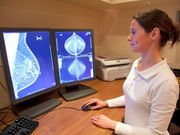For all screening intervals, benefits and over-diagnosis increase with breast density, relative risk
TUESDAY, Aug. 23, 2016 (HealthDay News) — For women aged 50 years and older, benefits and harms of breast cancer screening vary with risk and breast density for all screening intervals, according to a study published online Aug. 23 in the Annals of Internal Medicine.
Using collaborative simulation modeling, Amy Trentham-Dietz, Ph.D., from the University of Wisconsin-Madison, and colleagues estimated outcomes for various screening intervals after age 50 years based on breast density and risk for breast cancer.
The researchers observed increases in screening benefits and over-diagnosis with breast density and relative risk. With increasing risk, false-positive mammograms and benign results on biopsy decreased. Breast cancer deaths averted were similar for triennial versus biennial screening among women with fatty breasts or scattered fibroglandular density and a relative risk of 1.0 or 1.3 for those aged 50 to 74 years and 65 to 74 years. For women aged 50 to 74 years at all levels of breast density and a relative risk of 4.0 and those aged 65 to 74 years with heterogeneously or extremely dense breasts and a relative risk of 4.0, breast cancer deaths averted increased with annual versus biennial screening; however, harms were elevated almost two-fold. Per quality-adjusted life-year gained, the cost was less than $100,000 with triennial screening for the average-risk subgroup and annual screening for the highest-risk subgroup.
“The results show that for all screening intervals, benefits and harms change with risk and breast density,” the authors write.
Full Text (subscription or payment may be required)
Editorial (subscription or payment may be required)
Copyright © 2016 HealthDay. All rights reserved.








